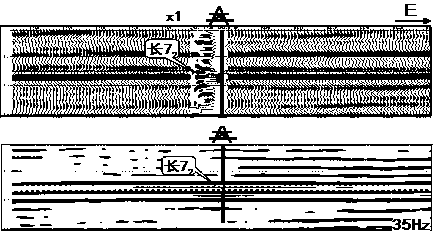A Prediction Method for Unconventional Tight Reservoirs under Strong Reflection Background
A technology for reservoir prediction and compaction, which is applied in the field of petroleum geophysical exploration, can solve the problem of indistinguishable thickness of sand bodies, and achieve the effect of improving the prediction coincidence rate
- Summary
- Abstract
- Description
- Claims
- Application Information
AI Technical Summary
Problems solved by technology
Method used
Image
Examples
Embodiment 1
[0021] This embodiment provides a method for predicting unconventional tight reservoirs under a strong reflection background, which is characterized in that it includes the following steps:
[0022] (1) Through forward modeling, establish the different frequency characteristics corresponding to sand bodies with different thicknesses in the target layer, and establish a forward modeling model library;
[0023] The forward modeling in step (1) is realized in the following way: multiple wells are selected for GS time-frequency transformation analysis, and the thicknesses of the target layers corresponding to these selected wells are different.
[0024] The wells selected in the forward modeling process include three types. The target layer sand bodies of type I wells are characterized by thick layers and massive layers, the target layer sand bodies of type II wells are characterized by thick layers and massive layers + thin interbeds, and the target layer sand bodies of type III w...
Embodiment 2
[0031] Such as figure 1 Shown is the length of well X1 An example of tight reservoir prediction, this embodiment will be combined with the specific implementation effect to illustrate, using GS transform time-frequency analysis technology, can better identify long Section 8m above the tight reservoir. Using the unconventional tight reservoir prediction method under the strong reflection background of the present invention, the Ordos Basin The tight reservoir prediction coincidence rate reaches 76.6%, which plays an important role in tight oil well location deployment and horizontal well area selection.
[0032] figure 1 In the figure, x1 well length The main frequency of the segment advantage is 35-45Hz, and the 35Hz single frequency profile is long Obvious response, long pre-drill forecast The thickness of the tight sand body is 10m, and the actual drilling is 9.2m. The seismic prediction is in good agreement with the actual drilling.
Embodiment 3
[0034] When using time-frequency analysis to predict unconventional tight reservoirs, according to the specific geological characteristics of different regions, through seismic forward modeling and combined with actual seismic data, the relationship between different sand body thicknesses and seismic spectrum should be determined.
[0035] figure 2 It is a comparative analysis chart of the seismic forward modeling section spectrum of 3 wells in the West 233 well area. It can be seen from the figure that the length of the X2 well is The thickness of the tight sand body in this section is 25.7m, the sand body is integrated, and the middle length of the forward modeling section is The dominant frequency of the section is 25-45Hz; x3 well site The tight sand body in this section is 12.3m thick, and there are massive sand bodies and thin interbeds in the forward modeling section. The dominant frequency of the section is 25-55Hz; x4 well length The sand body is not develope...
PUM
 Login to View More
Login to View More Abstract
Description
Claims
Application Information
 Login to View More
Login to View More - R&D
- Intellectual Property
- Life Sciences
- Materials
- Tech Scout
- Unparalleled Data Quality
- Higher Quality Content
- 60% Fewer Hallucinations
Browse by: Latest US Patents, China's latest patents, Technical Efficacy Thesaurus, Application Domain, Technology Topic, Popular Technical Reports.
© 2025 PatSnap. All rights reserved.Legal|Privacy policy|Modern Slavery Act Transparency Statement|Sitemap|About US| Contact US: help@patsnap.com


